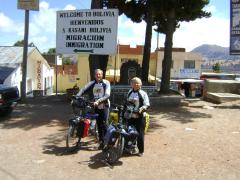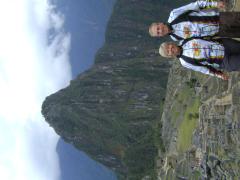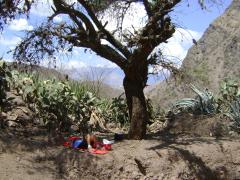rfay's blog
Peru Wrapup
Pictures from southern Peru and Northern Peru are up... And our route maps and elevation profiles are all up-to-date as well.
Peru was a delightful and challenging country for bicycle travel. The people are warm and open and cry out "Gringo!" from every field and household. (This may be rude in "gringo" terms, but it's just friendly banter from most Peruvians. Who knows why everybody does this in Peru!)
It was also a hard country. We climbed to passes as high as we've ever been (4700 meters, over 15,000 feet) and suffered endless dusty dirt roads. The toilets (or rather outhouses) (if they existed) in rural areas were often of the "squatter" type, not the "sitter" type, where you put your feet beside a hole and aim at the hole.
The country is incredibly beautiful, with striking snow-covered mountains, green rice paddies, huge rivers, and everything in between. And, of course, it has Machu Picchu, which has to be one of the world's most beautiful places.
It was cheap most of the time, except around Cusco and Machu Picchu, where they have the squeeze of the tourist down to a fine art.
Some price examples:
- Hotels: US$5-10 for the two of us. Sometimes surprisingly good.
How much does your bike cost?
Ever since we got to Mexico we've had to deal with the question in every little village: "How much did your bike cost?" It's embarrassing and difficult. Our bikes are ordinary mountain bikes, middle-of-the-road affairs, but they cost around US$1000, which is more than a year's income for a Guatemalan family. It's more money than most campesinos in the countries we've ridden through will ever see. So if we say "1000 dollars", they go into shock. I don't think it makes the bikes more likely to be stolen, but it's just a terribly uncomfortable thing to discuss.
In the past we tried: "About 2 weeks' salary" (very unsatisfactory to all, since it's an honest and open question. Some friends suggested lying and saying "$200" or something. That doesn't seem too good either. We've tried "It was a pre3sent; I don't know." Also unsatisfactory. Everybody knows we know.
But recently one answer has been very successful. We say "It's our custom not to talk about prices and expenditures." They immediately nod their heads and drop the question. Es nuestra costumbre no hablar de precios. Since I was raised not to talk about such things, it's absolutely true. And people really respect it since they're used to respecting other people's customs. Anyway, a recommended response!
Entering Bolivia!
We entered Bolivia today. We asked cyclists already in the country whether they were sensing any unrest or finding any problems, and none of them were. So we decided to head on in. And even the news shows that all the issues have been in the eastern part of the country, which was far from our route anyway.
The one hurdle we had to cross that we haven't anywhere else on our trip: We had to get a visa! There was a gob of paperwork and $135/person to be paid for the privilege. Bolivia started this program (exclusively for US citizens) several months ago in the interest of "reciprocity". It only makes sense. If Bolivian citizens want to go the US, they have to jump through all these hoops (and far more, really). And we knew about this hurdle for many months.
We had thought we could get the visa cheaper ($100) Bolivian consulate at the last city in Peru, Puno, but when we showed up at their doorstep they told us they were out of visas and didn't know when they'd come.
For other cyclists, our friend Andrew wrote a great article about how US cyclists get a Bolivian visa.
Pavement! Cusco to Lake Titicaca
We finally got started riding again and headed south from Cuzco on delightful paved road. It was paved all the way! Sometimes it was smooth, sometimes rough. Sometimes there was a good shoulder, sometimes not, but it was delightful. The traffic was moderate, the weather was good, the one climb (over a 4300 meter or 14,100 foot) pass was gentle. We took 5 days for the ride, and while we were tired when we got to Puno and Lake Titicaca, we were sure happy with the road.
We got to visit one ruin, Raqchi, that we'd never even heard of. But the guide was good and it was an interesting place, constructed in 1300 A.D. or so by the Incas apparently primarily as a food storage location, as there are more than 150 storerooms that were used for grain. But there were lots of artisans there too, as there still are today. read more here... lee mas aquí... »
Machu Picchu
Every tourist in Peru must go to Machu Picchu, the legendary lost city of the Incas. So we went! We took a tour of the Inca's "Sacred Valley" and then took the train to Aguas Calientes, the jumping off point.
In the morning we got up at 3:45am to start the hike up to the site, because we wanted to see the sun rise on the mountains. It was a good solid hike up the path (more sane people take the [expensive] bus up there). And it was delightful to see the light come up on the really steep green mountains all around us.
Up on top we took a tour (not the best) and then Randy hiked the steep staircase-like trail up to the top of the pointy mountain that's in the back of every Machu Picchu picture, Huayna Picchu. Nancy got out her watercolors and spent hours drawing the site.
The best part of the whole thing was just sitting and looking at the panoramic view of the site with Huayna Picchu in the background. You could just look at it forever. read more here... lee mas aquí... »
Security and Bike Touring in Latin America
The first thing to think about when discussing security is safety on the road. We're far more likely to be hit by a car or truck than to be held up by a robber. And probably most accidents don't even involve a car. None of ours has. So route choice, careful riding, a good mirror, and the like are more important than thinking about weapons and robbers and assaults.
But we need to think about those things. They happen here, and so here is our thinking.
Some of our advice is easy: Learn as much of the language as you can so you can communicate about security and understand what people tell you. Don't get involved with crooks or narcotics dealers. Pretty obvious.
Then:
- Ask the locals about the security situation and listen to them.
- Don't listen to stories from other travelers unless the events happened to them personally. Only very rarely should you heed anything you hear about a country from people in another country. They just have built-in fears.
- When camping, (at least from Mexico to Bolivia) either camp with a family or in a town if you can. Or if you're stealth-camping, camp where nobody will ever know you were there.
- Try to find out about outrageously insecure areas (the road from San Cristobal to Palenque in southern Mexico, or the town of Paiján in northern Peru come to mind)
- Never leave anything unattended, even if it's locked. There's kind of a philosophy in the Latin world that if you leave something unattended you didn't really want it.
In Cusco!
We have just arrived in Cusco, Peru. We will play tourist for a couple of days before going to the famous Inca ruins, Machu Picchu. We took the bus from Ayacucho to Cusco. During the 20 hour bus ride, the views where tremendous from the low river valleys up to the high mountain passes of 4300 meters. The road was mostly dirt, dusty and rugged. The central part of the Peru highlands are desert and dry, bone dry. The rainy season will start sometime near the end of September but for now it has been months without a good rain. I was very glad to be riding in a bus and not having to ride the terrible roads over five extremely high mountain passes and down to the hot dry river valleys. There was no in betweens, either it was up or it was down.
There was one bad thing that did happen. My camera got stolen in the market in Ayacucho right before we where going to catch the bus. I am so bummed and mad. We had our bikes fully loaded and we stopped to buy some bread. I was right next to my bike and Randy next to my bike. I was buying bread and some one distracted Randy with a stupid question which he turned to answer. When I returned to my bike, the camera was gone. There were so many people around and not one person saw what happened. The worst part of getting my camera stolen is the timing. It was one week before we go to the famous ruins of Machu Picchu. I will miss that 10x zoom.
The good news, all the photos backed up except for one day which is nothing in the scheme of things. read more here... lee mas aquí... »
FAQ: Don't you get tired?
This is an attempt to answer a Frequently-Asked-Question, both at home and on the road: Don't you get tired?
I think there are two different questions being asked. The first is, "Don't you get physically tired riding all that way?". The short answer to that one is: Yes, we get physically tired, and we rest and that solves it.
But the other question people are asking us is, "Don't you get tired of it? or bored?". And that one has a more complicated answer.
Yes, we sometimes do get tired of it. Sometimes the road is the same for a few days. Or the scenery and challenges seem to remain the same. Or the challenge seems a bit too much for a while.
Our standard prescription for a bike tourist that gets discouraged is easy: Rest for some time, and it won't seem so overwhelming. We know of one cyclist who, after riding all the way across Europe in record time, suddenly started feeling like all the people in the country where he was riding were looking at him wrong, like they were out to get him. We think he was tired, and should have slowed the pace, or stopped to rest a few days. But he was on a flight home within a couple of days, having aborted his trip. Cyclists often don't know how tired they really are.
Another thing that's important is to avoid dwelling on the ultimate destination. Our ultimate destination is Ushuaia, in Tierra del Fuego, at the bottom of South America. That's still a long way away. read more here... lee mas aquí... »





